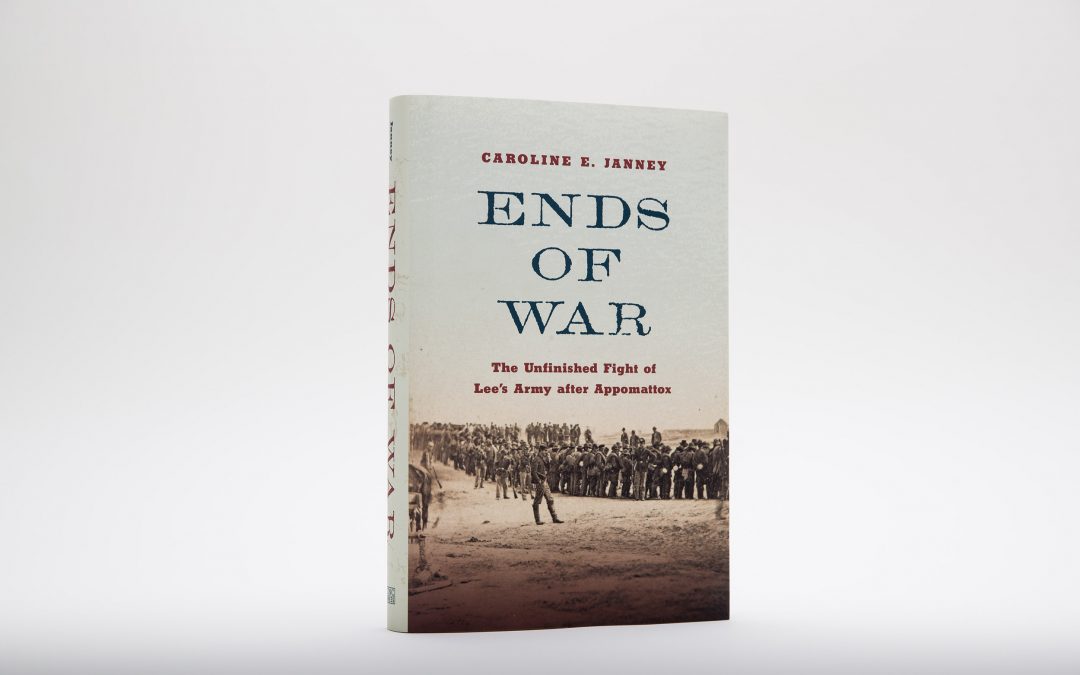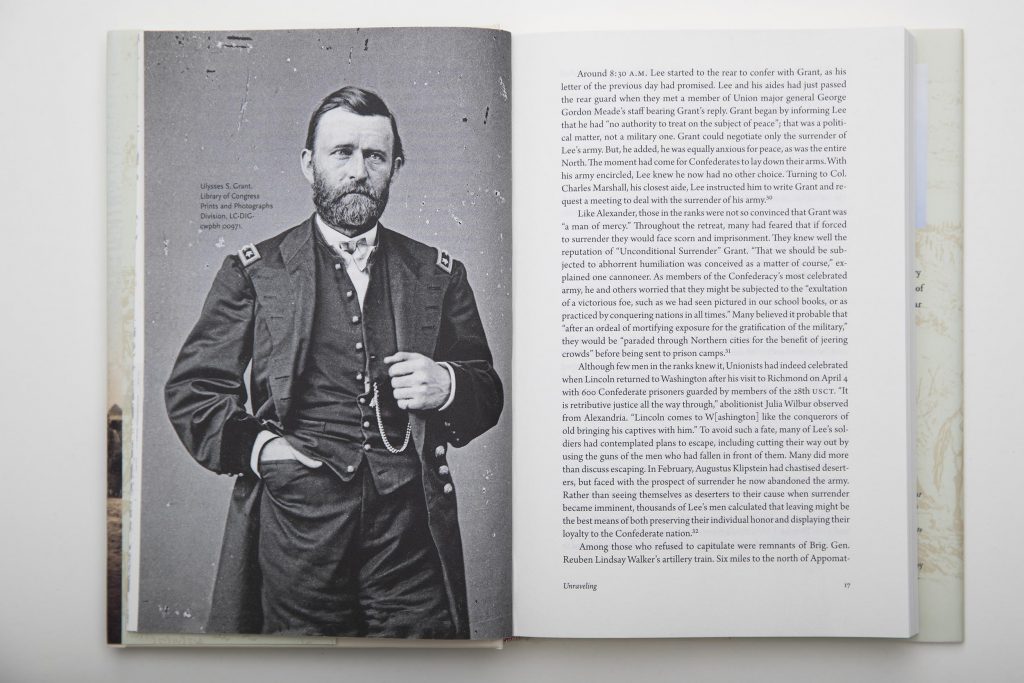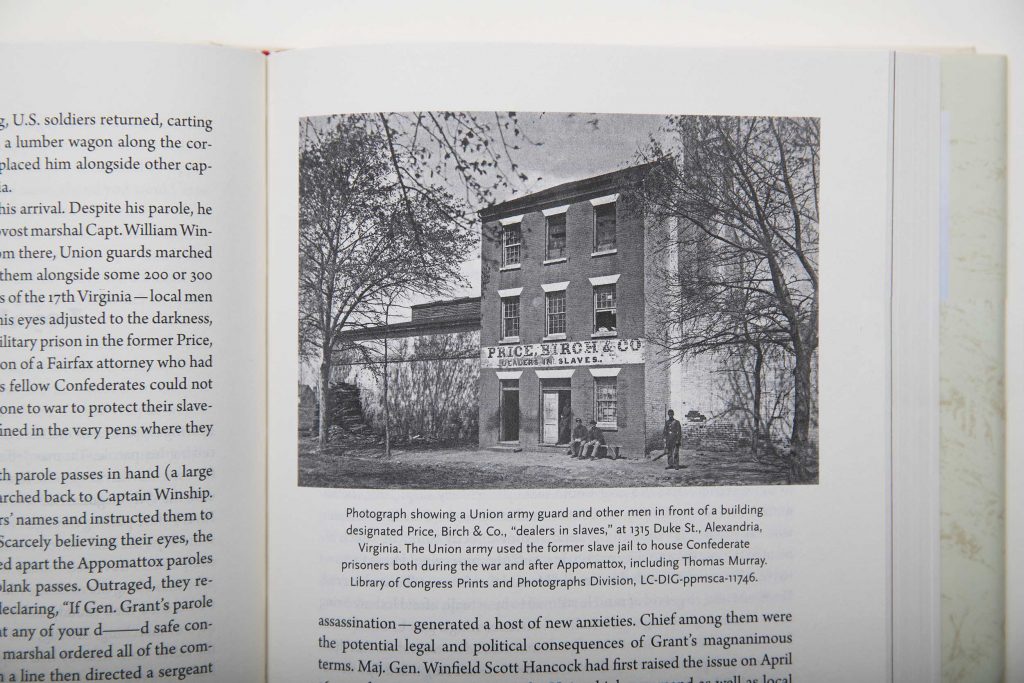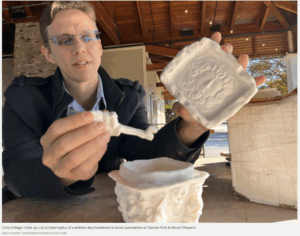Though the fighting stopped nearly 157 years ago, the American Civil War is still much on people’s minds.
“Studying the Civil War is more important now than ever,” Caroline Janney said. “It was a period when our democracy was truly under attack, when one section of the country refused to accept the results of the presidential election and decided instead to leave the union.”
Janney, the John L. Nau III Professor in History of the American Civil War at the University of Virginia and the director of UVA’s John L. Nau III Center for Civil War History, has examined the chaotic end of the military conflict in her award-winning book, “Ends of War: The Unfinished Fight of Lee’s Army after Appomattox,” looking at the way the war’s end shaped the peace that followed.
Gettysburg College and the Gilder Lehrman Institute of American History today awarded Janney the Gilder Lehrman Lincoln Prize, presented annually for a work that enhances the general public’s understanding of the Civil War era. Co-founded in 1990 by businessmen and philanthropists Lewis Lehrman and the late Richard Gilder, co-chairs of the Gilder Lehrman Institute of American History in New York and co-creators of the Gilder Lehrman Collection, the Lincoln Prize recipient is awarded $50,000 and a bronze replica of Augustus Saint-Gaudens’s life-sized bust “Abraham Lincoln: The Man.”
“Ends of War” opens just before Confederate Gen. Robert E. Lee’s surrender at Appomattox and details the collapse of the armed forces of the Confederate States of America through the spring and the summer, tracing the lives of many of the men who surrendered at Appomattox and were paroled; those who fled before the surrender and sought to join Confederate Gen. Joseph E. Johnston, whose army was still intact in North Carolina; and those who tried to return to their homes in loyal border states, particularly West Virginia and Maryland.
“I have always been struck by this period that seems to get lost in the narrative of the war and Reconstruction,” Janney said. “If we really slowed down time and look at what happens when a civil war, not just the United States Civil War, but any civil war comes to a close, what does that mean? What does that look like? How do you bring about peace in a nation that is fighting itself? What I really wanted to do is get down on the ground and take that apart to the best of my ability.”
On Their Honor
Union Gen. Ulysses S. Grant wanted to bring peace to the nation when he met with Lee. Following the directives of President Abraham Lincoln, Grant did not seek to humiliate the enemy or force them into prisoner of war camps. Such would have thwarted the war’s goal of reunion.
“It was the most important [provision] of the surrender: officers and men would be allowed to return to their homes, ‘not to be disturbed by United State Authority so long as they observe their paroles and the laws in force where they reside.’” Janney wrote in her book. “Contrary to his reputation, or even to the fears of those in Lee’s ranks, Grant did not demand an unconditional surrender. Instead, he offered the terms he thought would produce what he sought most: the capitulation of Lee’s army, which he hoped would be followed by the rapid surrender of all other Confederate forces.”
Grant sought a swift end to the military conflict and to avoid protracted and irregular warfare. He put the surrendered Confederate soldiers on their honor that they could return home and refrain from the fight.
“A parole … served only as a conditional freedom that relied heavily upon a soldier’s honor, especially in the case of Confederates who had been sent home,” Janney wrote in her book. “Those who violated their paroles faced execution if recaptured.”
In hindsight, there is a certain clarity in the end of the military conflict, but as Janney notes in her book, there was much less clarity at the time and the situation remained fluid.
“I think it is easy to look back now and say April 9, the day Lee surrenders to Grant, the war ends, but in that moment that was unclear,” Janney said. “And it went back and forth. People, including Lincoln, thought the war was over and he gave a speech from the White House after learning of Lee’s surrender, and there was great jubilation — fireworks going off from Winchester to San Francisco celebrating the end of the war. Lee had surrendered and Lee was seen as the most important Confederate; his army the most important.
“And then all of these other things start happening, not the least of which is the assassination, and people say maybe it isn’t over.”
By following the paths of officers and soldiers of the Confederate Army, Janney shows the challenges they faced and how these challenges changed over time, especially with Lincoln’s assassination. She traces the trails of the demobilized soldiers, recounting how the border state dwellers were rejected by their neighbors for their treason of joining the Confederacy. At the same time, those returning home to the Confederacy were supported by their communities.
“For those who support the Confederacy, they are overwhelmingly sympathetic to Confederate soldiers and feel the soldiers did the best they could do,” Janney said. “Throughout the book I offer examples of, to the extent possible, civilians taking care of Confederate soldiers as they come home, offering them what food they have left.”
Some soldiers were still zealous, refusing to surrender, and a few hundred fled the country.
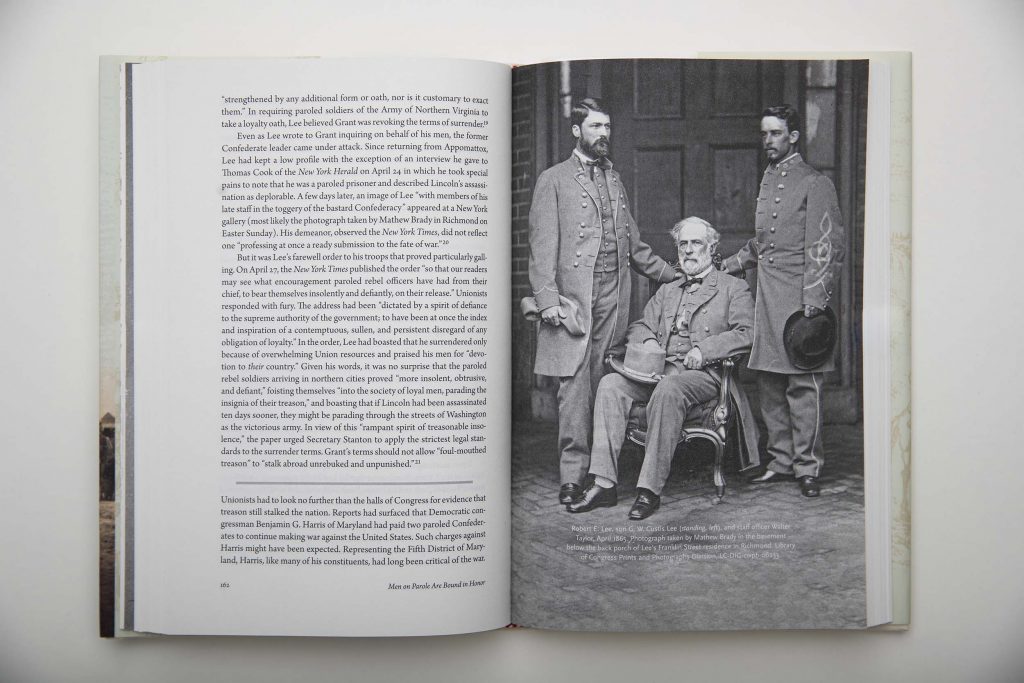
Gen. Robert E. Lee, flanked by his son G. W. Custis Lee, left, and staff officer Walter Taylor, in April 1865. (Photo by Matthew Brady/Library of Congress)
“There are pockets that go to Mexico, to Cuba, to Canada,” Janney said. “[Confederate Gen.] Jubal Early, who was not at Appomattox, went to Mexico, Cuba, and then up to Canada and would stay in self-imposed exile for several years. But the most significant numbers go to Brazil because Brazil is the last slave-holding nation in the Western Hemisphere.
“Gen. Porter Alexander, chief of artillery for Gen. James Longstreet’s corps, was not talking about continuing to wage the war on behalf of the Confederacy, but he went to Brazil,” Janney said. “He comes back, as almost all of them do. But Alexander had connections in Washington, D.C., and connections in New York, which is how he is able to make his way to South America.”
Some fled to Mexico with the thought of fighting in that country’s war with France.
“They just want to be soldiers and that is why they offer their services to [Emperor] Maximillian,” Janney said, adding that most of them came back home after a short while.
The Role of Confederate Women
Zealotry was not limited to the soldiers. Janney said that women in the Confederacy were also very invested in the cause, because the war put a new sense of purpose in their lives. Perhaps more important, they saw ending slavery as pulling the thread that would unravel the fabric of their Southern society, which was based upon the system of slaveholding. Janney said Southern white women had been largely excluded from not just the polity, but had been less likely than their Northern counterparts to join benevolent associations in the years preceding the war.
“When the war begins, Confederate women, as did their Northern counterparts, flocked to form ladies’ aid associations or soldiers’ aid societies,” Janney said. “What is really telling is that the Confederate government and the Confederate men more generally bend over backward to tell Confederate women how important they are to this war effort. To be fair, the war is primarily fought within the bounds of the Confederacy. They are on the front lines in a way that, with a handful of exceptions, Northern women are not. They see themselves as part of the war effort; they have been praised and given so much credit from Confederate men during the war that they had a fierce attachment to the Confederate nation.”
The end of the conflict was much less distinct for Confederate women.
“When the war ends, whatever that ending means, they don’t have the same ceremonial aspect,” Janney said. “They don’t have a moment when they are asked to lay down their guns; they don’t have a moment when they are asked to sign a parole pass. The war does not have this neat, tidy ending for them and their commitment and their zeal and their belief that they can continue fighting. I cannot tell you how many Confederate women’s letters and diaries, even into late April of 1865, are talking about, ‘The French are still going to come to our rescue. It will be just like Yorktown. They will sail into the harbor and we will all live to fight another day.’”
The unflagging dedication of Confederate women is one of the foundational bricks of the Lost Cause mythology that emerges from the end of the war.
“Confederate soldiers did not march away from Appomattox victorious, but they did come home unconquered,” Janney wrote in the epilogue of her book. “Many who surrendered at Appomattox marched home more like soldiers than the prisoners of war they were. Carrying with them the words of Lee’s farewell order, they admitted that they had been whipped on the battlefield and compelled to yield to overwhelming Union resources, but that had not meant that their cause had been unjust. The refusal to accept defeat was more than just the rhetoric of defiance. Those who escaped the surrender and rode south to join Johnston or west to the Shenandoah Valley clung to the cause.”
Janney notes in her book that “the seeds of Lost Cause orthodoxy had been planted during the war itself.” A Southern narrative that the war was for their independence, and which continued after the conflict, was a justification for what they had done.
“The Lost Cause was a salve,” Janney said. “It was a distorted and reimagined version of what happened, but for former Confederates, it was a way of explaining to themselves, but more importantly to the next generation, to their children and grandchildren, why they fought and why they lost.
“The Lost Cause has had such a powerful grip on the South and even the nation since its inception following the Civil War. But in some ways, we have to understand that it was part of the human psyche to try to understand and try to make sense of what this was all about. It’s a myth, and so it grows and with each generation more gets added onto it, and the story evolves. The myth can then be leveraged for everything from marketing products to justifying white supremacy.”
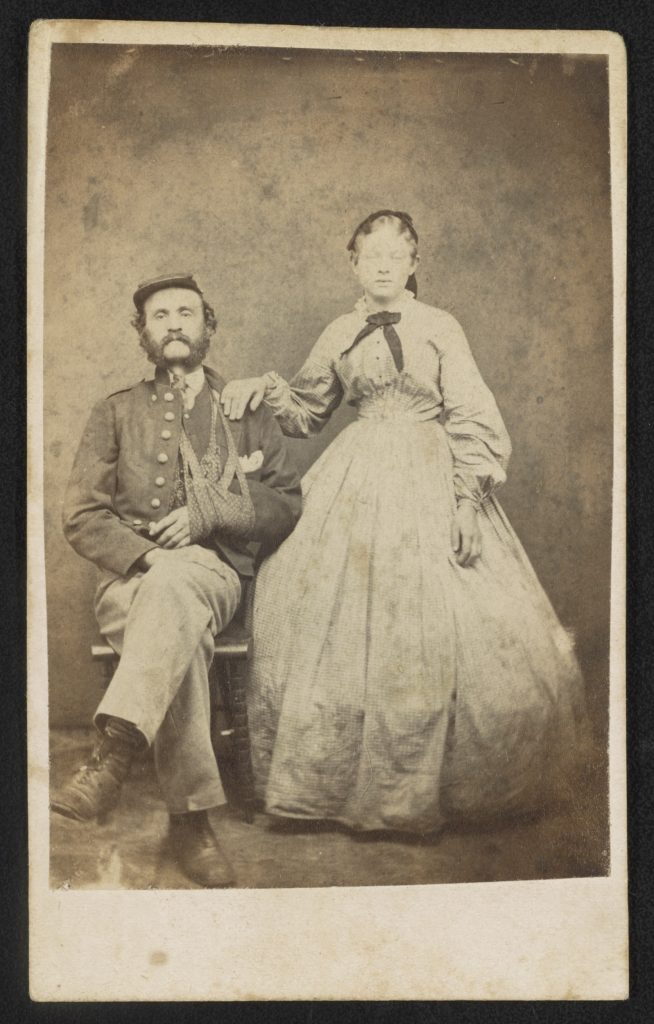
An unidentified Confederate soldier and his wife. Confederate women were a potent force in their support of the Southern forces. (Library of Congress)
The Lost Cause cemented the position of Confederate women in the Confederacy.
“The Lost Cause is very much grounded in and praising Confederate women for their loyalty and faithfulness to the cause,” Janney said. “And I have written a lot about these Confederate women and looked at lots and lots of speeches, Memorial Day speeches, monument dedications, Union and Confederate, and it is hard to find a Confederate dedication or speech where a Confederate veteran is not praising the loyal, devoted women on the home front. It is really difficult to find Union men doing the same thing, because they do not see women as being integral to their war effort as Confederate men do.”
While the paroled and unparoled Confederate soldiers were moving around the South, many of former enslaved people were also moving, some returning to their families.
“By the spring of 1865, enslaved people across the state have made their way to various Union posts, such as in Hampton,” Janney said. “A significant freemen’s village had been established at Robert E. Lee’s former home in Arlington, but they are also not necessarily making their way to Union lines and they are also going into urban areas.”
Richmond was swelling with African Americans from the surrounding communities making their way into the city.
“Unlike many of their rural counterparts who had either not learned of their freedom or remained tentative as to how they might claim it, African Americans in Richmond demonstrated no uncertainty,” Janney wrote in her book. “They had witnessed the USCT [U.S. Colored Troops], many of the soldiers former slaves, march into the Confederate capital on April 3 before gathering on Broad Street near Lumpkin Alley, site of the slave jails and auction houses.
“Among the soldiers stood Garland H. White, a formerly enslaved man from Virginia who had escaped to Ohio before joining the 28th USCT as a chaplain. Called on to give a speech by his comrades, he complied. ‘I was aroused amid the shouts of 10,000 voices,’ he recalled, ‘and proclaimed for the first time in that city freedom to all mankind.’ Within the cells of Lumpkin’s jail, enslaved men began to chant, ‘Slavery chain done broke at last!’”
Janney’s Journey
Janney’s fascination with the Civil War started at an early age, nurtured by her grandfather, a UVA student who left school during his third year to fight as a U.S. Marine in World War II.
“He was an avid reader of history, especially Civil War history,” Janney said. “And he took me to my first battlefields as a child – to Gettysburg and Antietam. He never said much, just walked the fields by himself while I went to the visitor centers with my grandmother. As an adult, I’ve often looked back and wondered what it meant to be a veteran and compelled to read and study about another war.”
Geography also played a role.
“I grew up in the Shenandoah Valley, so the Civil War seemed omnipresent – in the Confederate monuments, street names, high school names,” Janney said. “I was always interested in history, but especially that which was so tangible. In college, I worked at Shenandoah National Park as an archivist and historian, but I was majoring in government, because I thought I wanted to go to law school. My fourth year at UVA, I took a pass/fail class with [then history professor] Ed Ayers [later dean of the College of Arts & Sciences and president of the University of Richmond] and my path was forever altered.”
Americans maintain an ongoing fascination with the conflict.
“For some it is an American epic,” Janney said. “The scale of the war was enormous – more than 620,000 soldiers died. Moreover, this fighting took place on our own soil and we can visit these places. For some, it offers a story of the origins of the modern United States – of the modern nation-state, of centralized power, of modernity in warfare. For others, it is the moment when the great national sin of slavery, though not racism or white supremacy, was purged and democracy persevered.”
For her most recent book, Janney began her research reading soldier’s accounts of leaving Appomattox as she went through the National Park Service archives there.
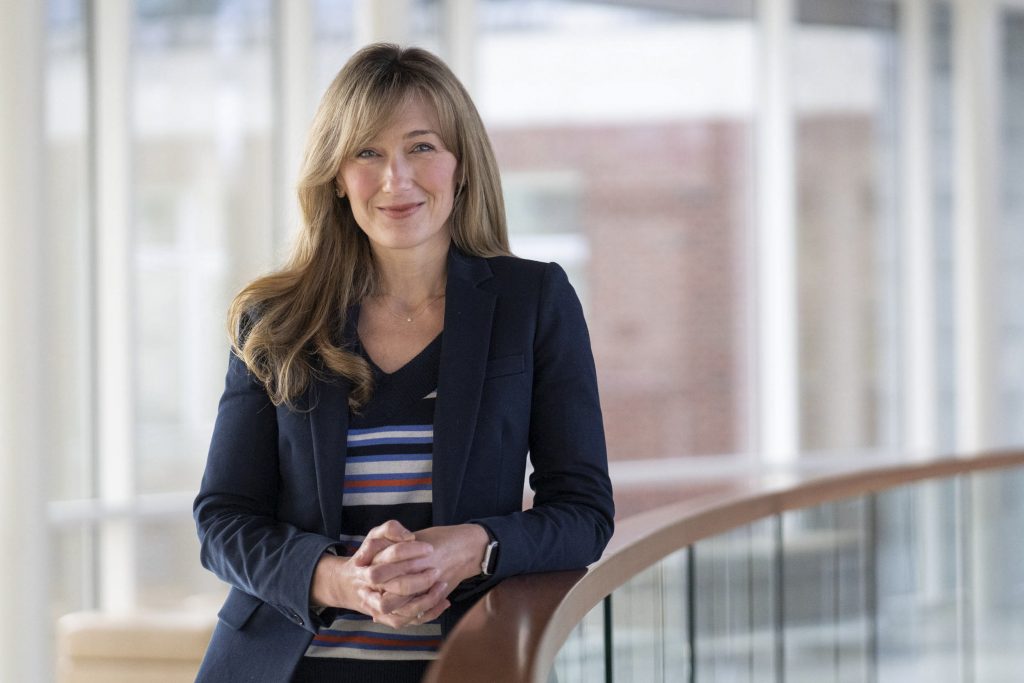
Caroline Janney grew up steeped in the Civil War, visiting battlefields with her grandparents. (Photo by Sanjay Suchak, University Communications)
“For years, they had been collecting diaries, letters, memoirs written by Confederates who had been leaving Appomattox,” Janney said. “That was the first kernel of my research, and from there I fanned out and was looking for every example of these men and as much of their voices as I could find. In addition to that, I spent an incredible amount of time in the National Archives looking through the military records for the Union perspective. That is where I came across all these paroles that were issued in places other than Appomattox, far beyond Appomattox. The research on African American voices was the most difficult to find, often buried in the accounts of Confederate soldiers or military records.”
Union Gen. William Sherman accepted Johnston’s surrender on April 26 in Raleigh, North Carolina, weeks after Lee’s surrender, and many Confederate soldiers who did not surrender at Appomattox turned themselves in later at various points to get paroles.
Janney went through military records in the National Archives, as well as spending time at UVA’s Special Collections, and other repositories across the country from the Huntington in California to the Boston Historical Society, looking for bits and pieces of the story.
“I am not sure what I expected to find, but I was surprised along the way in many different accounts,” Janney said, “number one being the number of men that were being paroled at places far beyond Appomattox; that is not something that people had really talked about before. The second was this obvious question of what to do about Confederates, rebels who had come from states that remained loyal to the Union, and the real quandary that posed not just for the government, but for local communities. And then there is the practical level of how did all of these men – whether that is 40,000, however you are counting – how did they physically get home when the infrastructure of the South had been so decimated by the course of four years of war?”
Despite the thousands of books written about the Civil War, Janney said there are still areas to examine.
“There is always more to learn,” Janney said. “We just need to alter our lenses and look at it through a different light. And we can understand more about the past. And the more we understand about the past, the more we understand about ourselves and the present, and I think that makes us better citizens of the world to have that humanistic perspective on the past.”
–news.virginia.edu

